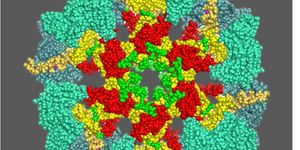Novel Techniques to Measure Bird Biodiversity and Habitat Quality in Agricultural Habitats
A recent study published in Ecological Applications examines how certain bird species are coping on 44 privately-owned agricultural sites throughout the state of Iowa. The team used new techniques, which included a mini cell phone microphone, circuit boards and a battery sealed in plastic bags, to monitor grassland birds on each site, along with remote sensing data, and holds the potential to help develop an inexpensive and low maintenance approach for monitoring wildlife on working lands at larger scales.
Study lead author, Dr. Adam Dixon, displaying one of a myriad of low-cost bioacoustic recorders used for the study. (Credit: Adam Dixon)
“Using novel methods, we found that agricultural habitats are good for birds in general, but when you look at grassland birds specifically, either there’s not enough habitat or the habitat characteristics aren’t good,” said Dr. Adam Dixon, who is a conservation scientist with the World Wildlife Fund, and lead author of the study.
The study was conducted on private land, with Dr. Dixon obtaining permission to place the microphones, and in some cases, the farmers placed the microphones themselves. The reason the study was conducted on private land was to help address the concerns local farmers have in terms of their own livelihoods while trying not to encroach on the environment.
For the study, the researchers used remote sensing data to analyze plant characteristics in each Iowan habitat, which the team referred to as the area’s “texture”, and used the aforementioned microphone system to monitor which bird species were present in each habitat, as well. A combination of these techniques demonstrated its low cost and low maintenance abilities, meaning this study could be scaled up for larger areas.
The study’s findings indicate that greater habitat areas and textures resulted in greater numbers of bird species. In contrast, the team also found that bird species who permanently lived on grassland habitats were lesser off than bird species who used grassland habitats temporarily, such as hunting.
The goal of the study was to help raise awareness of establishing a balance between farming and environmental preservation, which Dr. Dixon hopes to continue to address in further studies.
“We need to integrate conservation solutions into our most intensive places,” said Dr. Dixon. “So, this research identifies that as an area of valid research and also shows how that research might be done.”
What new discoveries will researchers make about working lands and environmental conservation in the coming years and decades? Only time will tell, and this is why we science!
As always, keep doing science & keep looking up!
Sources: Ecological Applications, EurekAlert!









